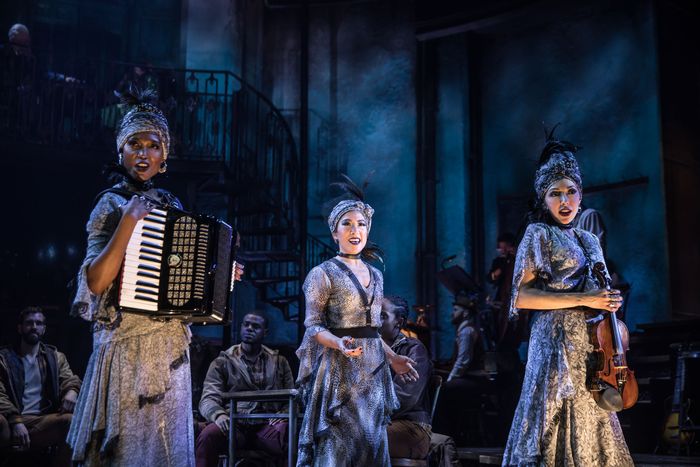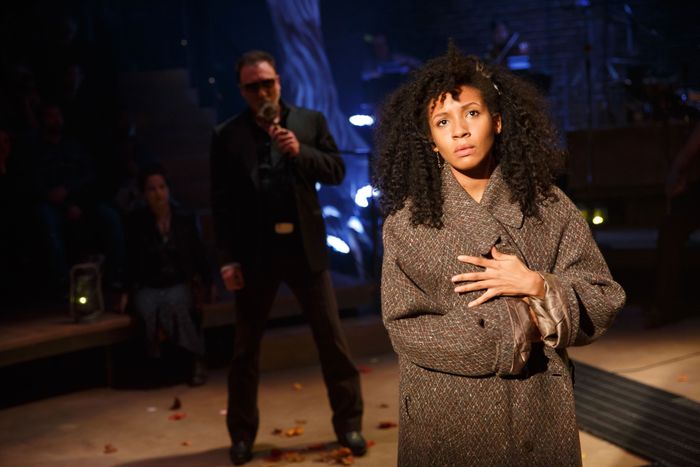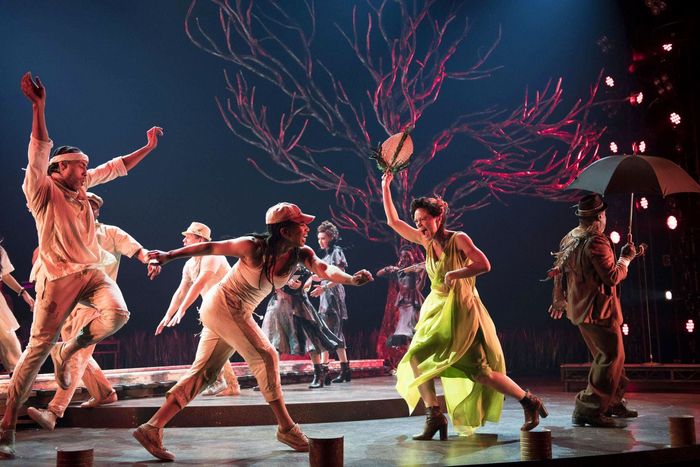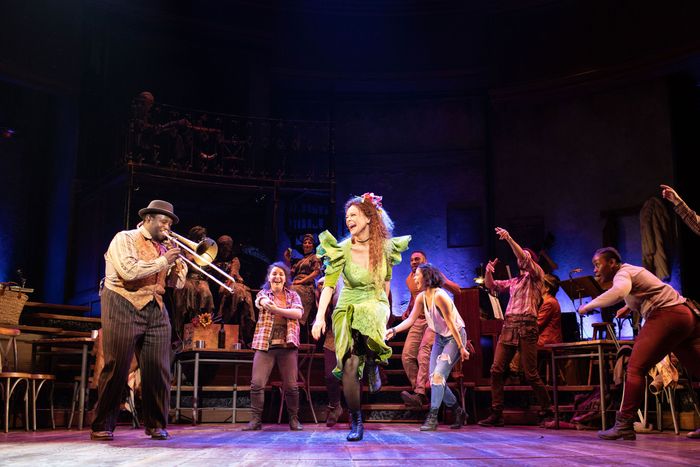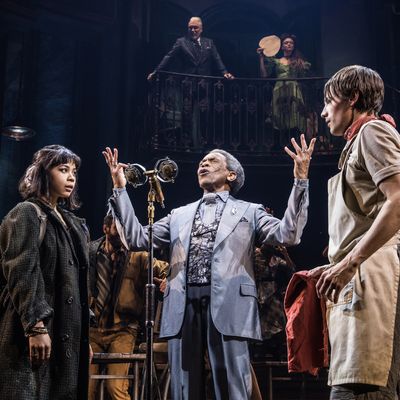
When Anaïs Mitchell and Rachel Chavkin talk about Hadestown, they often resort to metaphor. In simplest terms, the folk musical combines two Greek myths — of Orpheus and Eurydice, and Hades and Persephone — but it resonates with other valences: There’s Hades’s industrial underworld versus the organic place above, a potential allegory for climate change; there’s the perspective of the cynical gods versus the idealistic young lovers; there’s even a song about building a wall to keep out the poor, written well before that became a campaign promise. The story, the creators often insist, is closer to poetry than prose, which has also made it devilishly hard to stage — how do you manifest all those ideas onstage, and also, you know, make a good show? “I’ve never worked on anything as delicate as this piece, and maybe because it’s poetry, it’s so breakable,” Chavkin says. “It has gone through multiple breakings, in a sense, over the course of it. That’s the only way that we’ve learned.”
To use the appropriate organic metaphors, Hadestown started as a seed with a community-theater project that Mitchell, a songwriter, first performed in Vermont in 2006. That grew into a concept album in 2010, which she recorded along with folk musicians like Bon Iver’s Justin Vernon. By 2013, Mitchell started working with Chavkin — who had been directing The Great Comet Off Broadway — to plant Hadestown back onstage. They took it to New York Theatre Workshop in 2016 and then to Edmonton’s Citadel Theatre and London’s National Theatre before returning to Broadway, where the show began performances on March 22. Along the way they experimented with everything from the set design, to the size of the cast, to their way of thinking about the main characters’ roles in the story.
Early Development
Mitchell started work on Hadestown when she was starting out as a songwriter. “I would go to a show of even my favorite songwriter, and I would start to get bored,” she said. “Because it’s just so many songs in a row.” Inspired by song-driven theater pieces like Les Misérables and Sweeney Todd, she was drawn to the idea of developing a larger narrative in music. She developed Hadestown in a DIY form in community theaters in Vermont, where it had something of a plot, but was largely a concert piece.
That concert piece became a concept album, released in 2010, but Mitchell was still interested in moving it to the stage — she just didn’t know how to do so. She worried a standard musical-theater collaborator might force Hadestown “to fit a mold that it was never gonna fit” or make it “cheesy.” But then she met Chavkin, and the director mentioned that her favorite movie was Synecdoche, New York. “It’s dramaturgically so weird that I was like, ‘Maybe this is the right partner for me,’” Mitchell said. (“It still is my favorite movie,” Chavkin laughed.)
Early Workshops and New York Theatre Workshop
In the summer of 2014, Mitchell and Chavkin started working together on Hadestown in earnest with a workshop at Dartmouth through a New York Theatre Workshop residency. “It was many, many late nights with booze and singing,” Chavkin recalled. “There were a lot of new songs,” Mitchell said. “[But] at the end of the thing, everyone was like, ‘Great songs, but we have no idea what’s happening.’” That’s when they developed the character of Hermes (then played by Taylor Mac) into a narrator and provided recitative, musical dialogue for the characters between songs.
By 2016, they brought the show to New York Theatre Workshop proper, where they faced a lot of the literal questions that come with staging: What’s the scenic design? What are the costumes? What’s the choreography? They settled on an aesthetic that recalls both an amphitheater and a music hall, mixing Greek elements with Americana. There, the cast included Amber Gray and Patrick Page as the quarreling gods Persephone and Hades, both of whom have stayed with the show throughout the rest of its development, and grounded it, according to Mitchell and Chavkin. “There’s something sort of ‘just add water’ about the couple,” Mitchell said of their performances. “Who doesn’t love a ruined older marriage?” Chavkin added.
Citadel Theatre, Edmonton
They stuck to a concert format with microphones for the NYTW run, but Chavkin and Mitchell had the space and the money to add new elements when Hadestown settled down in Edmonton in 2017. There, they introduced a “Workers Chorus,” performing choreography by David Neumann, that Chavkin says also elevated the political undertones of the story. “Adding the Workers Chorus more than anything made clear the stakes of Orpheus’s walk in this world,” she said. “The two lovers’ ascent out of Hadestown is not just gonna change Eurydice’s life, but is going to change the workers’ lives as well.”
Canada was also where Chavkin and Mitchell realized a few ideas wouldn’t work. Initially, they worked with set designer Rachel Hauck to place the opening of the show on a set of railroad tracks to hell, an emptier setting that would leave many of the actors offstage, unlike the concert format at NYTW. “It was very bleak and very beautiful,” Chavkin said. “And we got into tech and it was awful. We sucked all of the life and vibe out of this show.” They cut “three-quarters” of the Act One set and brought Gray and Page’s gods back onstage at the top of the show — sitting by themselves like they’re “having oysters and waiting to enter” — in an attempt to re-create the more communal vibe the show had in New York.
National Theatre, London
In London, Mitchell and Chavkin had more time — and money, given the theater’s generous government subsidies — to expand on the ideas they’d been working on in Canada. “London was really the first time that David got to spread his wings and have an ensemble that was truly able to execute some major movement,” Chavkin said of the choreography. It was also when Hadestown got time with the National’s elaborate turntable and lift mechanism, which also became integral to its Broadway staging. “There are these beautiful moves [in the choreography] that then are further mechanized with the use of the turntable,” Chavkin said.
At the National Theatre, Hadestown also solidified its principal cast, bringing on Miss Saigon’s Eva Noblezada as Eurydice and André De Shields as Hermes alongside Reeve Carney (who joined in Edmonton) as Orpheus, as well as Amber Gray and Patrick Page. With the cast in place, Mitchell and Chavkin started to dig deeper into the characters, specifically the relationship between Orpheus and Eurydice. Orpheus in particular was the hardest character to write, in large part because he is the character closest to Mitchell in the show. “I just assume that people are going to love a singer-songwriter because I am one,” she said with a laugh. “But it’s not always the case.”
Walter Kerr Theatre, Broadway
Preparing for their opening on Broadway, Mitchell and Chavkin were still refining elements of Hadestown and continued to develop Orpheus as a character. “Reeve’s work has grown and altered and deepened in terms of the character work because there’s now so much more specificity built around him,” Chavkin said of his performance. Carney joked that he was glad he wasn’t asked to reaudition for the role because “it’s completely different,” Mitchell recalled.
There are also tweaks to the staging, to the costumes, and bits of characterization, and crucially, more rhymes that Mitchell has had to work quickly to develop. “I hit a moment last night where I was like, It’s fucking now or never,” she said. In other words, it’s pressure time for something that has developed slowly up until now, always with an eye to a Platonic kind of perfection. Mitchell remembered one stanza she developed and abandoned in a workshop, never to make it into the show: “Orpheus was a poor boy but he had a gift to give. There was one song he’d been working on he could never seem to finish. A song about this broken world he rewrote again and again. As though if he could find the words, he could fix the world with them.”
“I feel like that,” she said. “What all of us as artists are trying to do is all of this work, all of this rewriting; this idea that you could fix the world somehow — if you could find the right words.”



